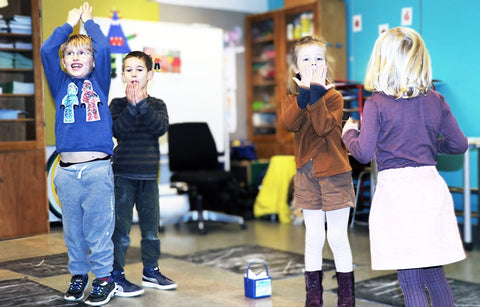
Reading is a complex and crucial skill that impacts the ability of youth to perform as students, across social contexts and in their eventual working lives. Therefore, it is important to develop reading skills during childhood.
Now, a team of researchers from the University of Copenhagen and Denmark’s National Center for Reading has focused on whether whole-body learning in instruction, known as embodied learning, has a positive impact on children’s ability to learn letter sounds.
Twice as Good with Difficult Letter Sounds
"Our research demonstrated that children who used their whole body to shape the sounds of letters became twice as proficient at letter sounds that are more difficult to learn compared to those who received traditional instruction," says PhD student Linn Damsgaard of UCPH’s Department of Nutrition, Exercise and Sports.

"There are many difficult letter sounds in Danish and these sounds are particularly important, because once children become proficient at them, it has already been shown that they will be better readers."
The project included 149 children, 5 – 6 years old, who had just started school. They were divided into three groups: one that stood up and used their whole body to shape letter sounds; a seated group that shaped letter sounds with their hands and arms; and a control group that received traditional, seated instruction during which they wrote letters out by hand.
The study also demonstrated that students who shaped difficult letter sounds with hand movements while seated also had a greater increase in proficiency than the control group.
Adding Movement Increases Motivation
Associate Professor Jacob Wienecke of UCPH’s Department of Nutrition, Exercise and Sports led the study and explains the project’s background:

"The overarching goal is to learn more about which methods can be used to give beginner readers a good start. The idea is that if, through play and movement, we can reach children where they are and where their strengths truly lie – and we can create a form of learning that combines reading with play – then that's truly positive."
The study also investigated whether a direct effect of embodied learning could be found through children's reading of individual words. This was not possible, which may be due, among other things, to the fact that the children were at such an early stage of their literacy development that they could not yet transfer their knowledge of letter sounds to reading words. Or, as PhD student Linn Damsgaard describes it: "Just because you learn the notes and sounds of a flute, doesn’t make you a master.
StepUp Note
When we use body movement to support our learning, this is called “embodied cognition.” Neuroscience research shows how the coordinated firing of many neurons strengthens the neural networks that we use for learning. Recent research continues to show us how we can benefit from using movement to help us learn and remember. The StepUp programs combine whole-body coordination with rhythmic movement, hand movement, vision and talking. These neural network learning programs help children develop fluent basic skills for reading decoding, math fact retrieval and handwriting.
Reposted from University of Copenhagen
Note by Nancy W Rowe, M.S., CCC/A
